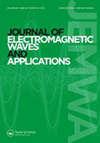An efficient and low-profile metasurface-based polarization converter with linear and circular polarization efficiencies for X- and Ku-Band applications
IF 1.1
4区 工程技术
Q4 ENGINEERING, ELECTRICAL & ELECTRONIC
Journal of Electromagnetic Waves and Applications
Pub Date : 2023-09-27
DOI:10.1080/09205071.2023.2262985
引用次数: 0
Abstract
AbstractIn this study, a metasurface-based linear and circular polarization converter operating on the reflection mode is proposed for X- and Ku-band microwave applications. The proposed converter offers an optimum performance with a polarization conversion ratio (PCR) and polarization matching ratio (PMR) greater than 93% in the 8.32--17.55GHz bandwidth for a linearly polarized in the y-direction and right-handed circular polarized (RHCP) incident waves. Besides, the design performs over 80% PCR performance up to 45∘ under oblique incidence. Moreover, the proposed converter is capable of left-handed circular polarization conversion between 7.42 and 7.68 GHz for a y-polarized incident wave. The design offers a relative bandwidth (RBW) of 71.36%. The converter design is constructed with metal termination, an easily accessible FR-4 substrate and a simple design metasurface. Surface currents of the polarization converter at resonance frequencies of 8.77, 12.88 and 16.7GHz were examined to understand its working mechanism. In addition, when the proposed design is rearranged with the appropriate geometry, the monostatic RCS reduction value in the 8.0–17.7GHz range is observed to be higher than 10 dB. CST program (a commercial 3D electromagnetic simulator) was used in simulations. The simulated device was fabricated with a traditional board fabrication technique. Simulation results were verified with free space measurements calibrated by the thru-reflect-line calibration procedure. The performance and efficiency of the proposed polarization converter were compared with other converters in the literature.Keywords: Metasurfacepolarization conversionlinear polarizationcircular polarizationX-band and Ku-bandRCS reduction Disclosure statementNo potential conflict of interest was reported by the author(s).Additional informationNotes on contributorsMuhammed Fatih CorapsizMuhammed Fatih Corapsiz received the B.S. degree from Firat University, Elazig, Turkey, in 2003, and the M.S. and Ph.D. degrees from Ataturk University, Erzurum, Turkey, in 2009 and 2014, respectively, all in electrical and electronics engineering. Since 2016, he has been an Assistant Professor with the Department of Electrical and Electronics Engineering, His research interests include mechatronic and robotic systems, solar energy, dc-dc converters and metasurface-based linear and circular polarization converters.一种高效、低轮廓的超表面极化变换器,具有线性和圆极化效率,适用于X波段和ku波段应用
摘要:本研究提出了一种基于反射模式的超表面线性和圆偏振变换器,用于X波段和ku波段微波。在8.32 ~ 17.55GHz带宽范围内,对于y向线极化和右手圆极化入射波,该变换器的极化转化率(PCR)和极化匹配率(PMR)均大于93%,具有最佳性能。此外,该设计在45°斜入射下的PCR性能超过80%。此外,对于y偏振入射波,该变换器能够在7.42 ~ 7.68 GHz范围内实现左旋圆偏振转换。该设计的相对带宽(RBW)为71.36%。转换器设计采用金属端接、易于访问的FR-4基板和简单的设计超表面。对极化变换器在8.77、12.88和16.7GHz谐振频率下的表面电流进行了测试,以了解其工作机理。此外,当采用适当的几何形状重新排列所提出的设计时,观察到在8.0-17.7GHz范围内的单稳态RCS降低值高于10 dB。采用CST软件(商用三维电磁模拟器)进行仿真。采用传统的制板工艺制作模拟器件。仿真结果与自由空间测量通过反射线校准程序进行了验证。将所提出的极化变换器的性能和效率与文献中其他变换器进行了比较。关键词:超表面偏振转换线性偏振圆偏振x波段和ku波段rcs降低披露声明作者未报告潜在利益冲突。muhammad Fatih Corapsiz于2003年在土耳其埃拉齐格的Firat大学获得学士学位,并于2009年和2014年分别在土耳其埃尔祖鲁姆的Ataturk大学获得电气和电子工程硕士和博士学位。自2016年起,他一直担任电气与电子工程系的助理教授,他的研究兴趣包括机电和机器人系统,太阳能,dc-dc转换器和基于超表面的线性和圆极化转换器。
本文章由计算机程序翻译,如有差异,请以英文原文为准。
求助全文
约1分钟内获得全文
求助全文
来源期刊
CiteScore
3.60
自引率
7.70%
发文量
116
审稿时长
3.3 months
期刊介绍:
Journal of Electromagnetic Waves and Applications covers all aspects of electromagnetic wave theory and its applications. It publishes original papers and review articles on new theories, methodologies, and computational techniques, as well as interpretations of both theoretical and experimental results.
The scope of this Journal remains broad and includes the following topics:
wave propagation theory
propagation in random media
waves in composites and amorphous materials
optical and millimeter wave techniques
fiber/waveguide optics
optical sensing
sub-micron structures
nano-optics and sub-wavelength effects
photonics and plasmonics
atmospherics and ionospheric effects on wave propagation
geophysical subsurface probing
remote sensing
inverse scattering
antenna theory and applications
fields and network theory
transients
radar measurements and applications
active experiments using space vehicles
electromagnetic compatibility and interferometry
medical applications and biological effects
ferrite devices
high power devices and systems
numerical methods
The aim of this Journal is to report recent advancements and modern developments in the electromagnetic science and new exciting applications covering the aforementioned fields.

 求助内容:
求助内容: 应助结果提醒方式:
应助结果提醒方式:


